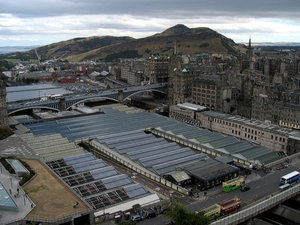Waverley station
|
|

Waverley Bridge is at the bottom right, North Bridge in the middle heading right (southward) to the old town. Arthur's Seat is in the background.
Waverley Station is the main railway station in the Scottish capital Edinburgh. Covering an area of over 25 acres (101,000 m²) in the centre of the city, it is the second largest mainline railway station in the United Kingdom—the largest being London's Waterloo station.
The station is located in steep, narrow valley between the city's mediaeval Old Town and the 19th century New Town. Princes Street, the city's premier shopping street, runs along one side of the station. The valley is bridged by the 1897 North Bridge (a three span iron and steel bridge, which passes high above the station's eastern section) and Waverley Bridge (which, by means of ramps, affords one of the main entrances to the station). This valley was formerly filled by a freshwater loch, the Nor'Loch, but this was drained in the early 19th century.
Trains leave Waverley in two directions:
- Eastward are the suburban services to Newcraighall and the North Berwick branch line, and the East Coast Main Line. The proposed reopening of the Waverley Route, which will reconnect several towns in the Scottish Borders to the railway network, will also enter Edinburgh from the east.
- Westward the line runs through a cutting near the cliffs of Edinburgh Castle and through Princes Street Gardens. It then passes through a tunnel before emerging at Haymarket Station. From there lines lead north to Fife over the Forth Bridge, west to Glasgow, and north-west to Stirling and Dunblane.
History
With the growth of the city, and the construction of the "scientifically designed" New Town to the north, the Nor'Loch became a fetid open sewer, something at odds with the city's modern Scottish Enlightenment aspirations. Works were undertaken to drain the loch and properly direct the city's sewerage, and by 1820 the loch was largely dry and the land was available for development. Much was used to build Princes Street Gardens, an extensive landscaped park. With the explosion of railway travel in Britain underway, three railway companies each built stations near one another in the valley, opening over the course of the 1840s. The collective name "Waverley", after the Waverley novels by Sir Walter Scott, was used for the three from around 1854. The Scott Monument stands in Princes Street Gardens near to the entrance to Waverley Station. In 1868 the North British Railway Railway company acquired the stations of its rivals, demolished all three, and built the present Victorian station. Waverley has been in continual use since, under the auspices of the North British, later LNER, British Rail, and latterly the post-privatisation railway companies.
Current and future uses of the station
Wfm_waverley_ceiling.jpg
As at other large railway stations of the Victorian and Edwardian eras, the railway company constructed a grand station hotel beside their station. The North British Hotel, situated adjacent to the station on Princes Street, opened in 1902. In 1983 British Rail sold it to the Forte hotel group. In 1988 Forte closed the hotel for a year to extensively remodel and update what had become something of a faded jewel. When it reopened it was rechristened The Balmoral Hotel (in what has proved to be an astute marketing move, despite the hotel being 115 miles from Balmoral Castle). It enjoys commanding views over central Edinburgh, and is one of the most luxurious (and expensive) hotels in the UK.
The station's large size and the unusual topography of its surroundings mean that it contains a large amount of valuable, centrally located land. The station's successive owners, British Rail, Railtrack and its current owner Network Rail have been criticised for underutilising the valuable city-centre spaces available within. Princes Mall (formerly the Waverley Shopping Centre), which occupies a column of space nestling between Waverley Station, Waverley Bridge, and Princes Street, opened in the early 1990s.
Plans have been drawn up for the latest, long-awaited redevelopment of the station. This will improve facilities and provide more through platforms for trains passing from the East Coast Main Line to the rest of the Scottish network.
External links
- Station information (http://www.networkrail.co.uk/Stations/stations/EdinburghWaverley/Default.aspx) on Waverley Station from Network Rail
Template:UK Major Railway Stations
| UK railway stations: |
